This post will give you a clear and practical framework for conducting a market analysis.
We’ll start with the basics first. Then move on to discussing the exact steps you need to take to analyze any market.
And it won’t take more than 60 mins—we promise.
Let’s begin.
What Is a Market Analysis?
A market analysis is the process of learning everything you can about your target market.
It’s like doing your homework to prepare before launching and growing your business.
You don’t want to enter a market without knowing who you’re serving, who you’re competing with, and what’s happening in your industry.
That’s a recipe for failure.
Instead, you want to do your research to gather as much data and insight as possible.
Why Perform a Market Analysis?
Market analysis helps you answer big business questions like:
- What is your market’s total size? (This is something you can see in Market Explorer, which we’ll go over when we discuss getting a high-level look at your market.)
- Who are your target customers? And what are their unique attributes?
- Who are your competitors? And how do they attract customers?
- What are the opportunities and threats that exist in your market?
By answering these questions, you’ll be able to:
- Determine whether your business will be viable
- Develop marketing strategies to attract customers
- Formulate plans to outperform your competitors
- Measure and improve your performance
In short, a market analysis helps you grow your business faster and smarter.
But how do you perform a market analysis? And what are the best tools and methods to use?
Let’s find out.
How to Do a Market Analysis
Follow our six-step process to analyze any market.
1. Determine the Purpose of Your Analysis
First off, take a moment to ask yourself why you’re doing this analysis.
Is it because you’re launching a new product and need to evaluate the whole market landscape?
Or maybe you’ve already launched your product but are now looking to find the best channels for marketing.
Your purpose could be related to anything you want to learn about. And it’s going to shape your entire analysis.
Here’s the best way to nail down your purpose:
- Grab a pen and paper (or open up a new Google Doc)
- Write why you want to do a market analysis. Don’t overthink it—just write whatever pops in your head.
For example:
You’re doing a market analysis to launch a new accounting software. And your goal is to find answers to these questions:
- How big is the accounting market and does a business opportunity exist?
- Who are your ideal customers and what are their unique characteristics?
- Who are the existing players in the market and how do they position themselves?
- What are the best ways to reach and attract your potential customers?
Based on the analysis, you’ll decide the best way to launch and grow your business.
2. Research Your Market’s Overall Landscape
Now that you’re clear on why you’re doing market analysis, it’s time to get a bird’s-eye view of your market. And information like market size, competitors, opportunities, etc.
Use Semrush’s Market Explorer tool for this.
Open the tool and select the “Analyze Category” tab.
Then, choose your industry from the drop-down menu and click “Research a market.”
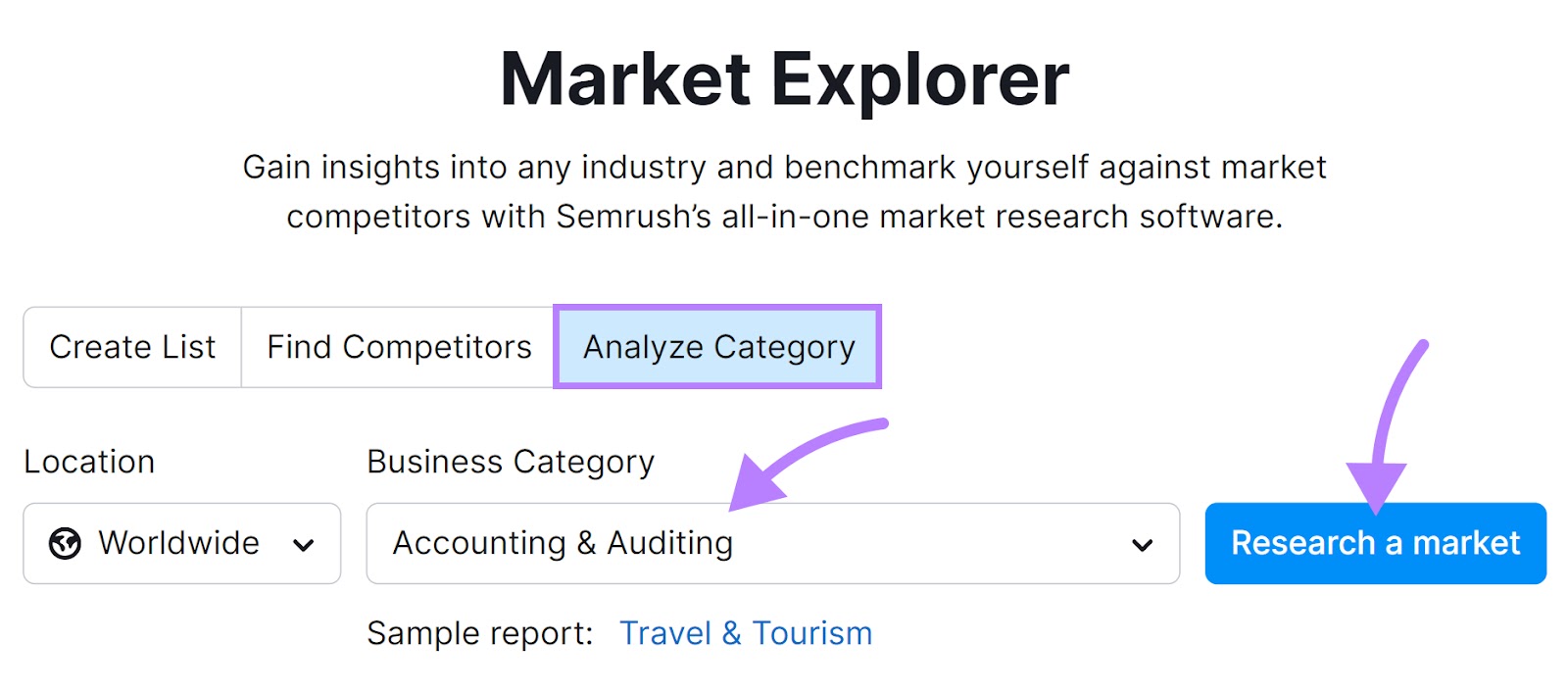
You’ll get a high-level overview that touches on
- Market Consolidation: A low level of consolidation means there are many smaller businesses in the market, and you have a good opportunity to enter this market
- Market Traffic: The total amount of potential website traffic in your market. The higher this number, the better.
- Market Size: The total number of potential buyers in your market
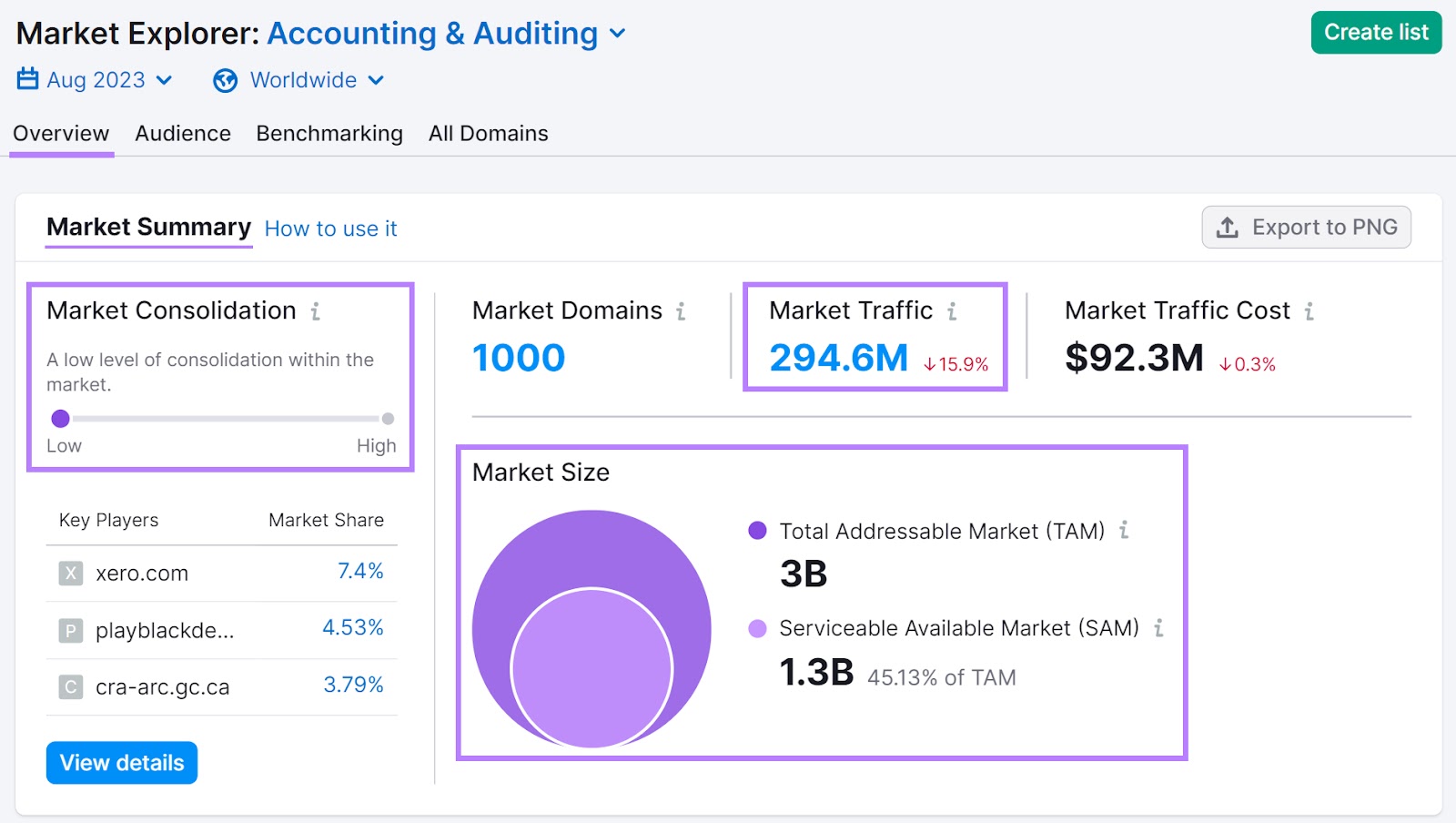
Remember:
You’re not deep-diving into details at this stage.
You’re getting a high-level view of your industry. To better understand its dynamics and how your business could fit into this bigger picture.
You’ll also see which countries present the best opportunities for your business.
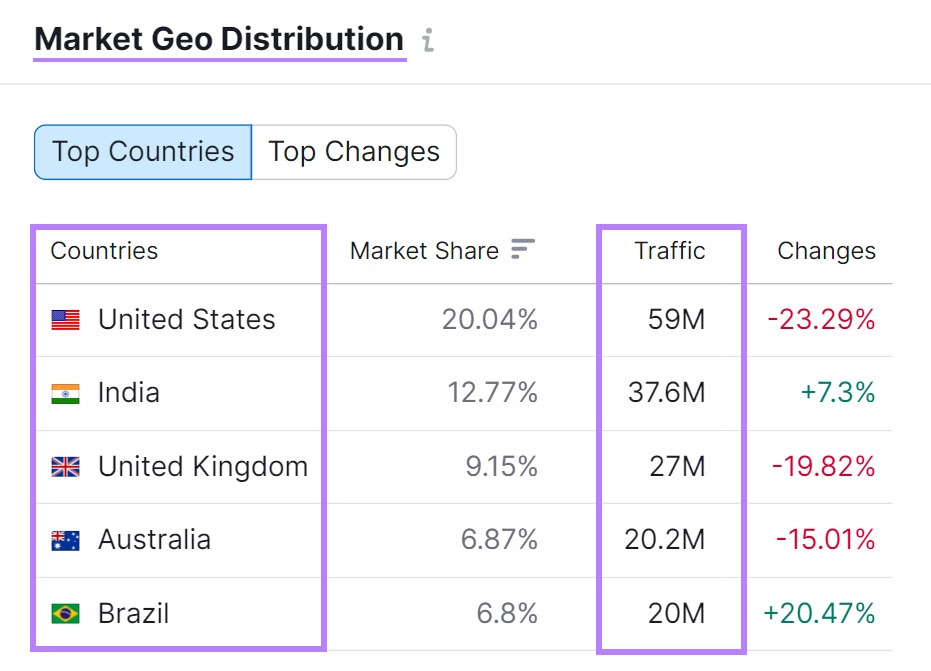
Use this information to determine which markets are worth pursuing. And know that markets with a high amount of traffic are likely to be more lucrative.
You’ll also see existing players in the market.
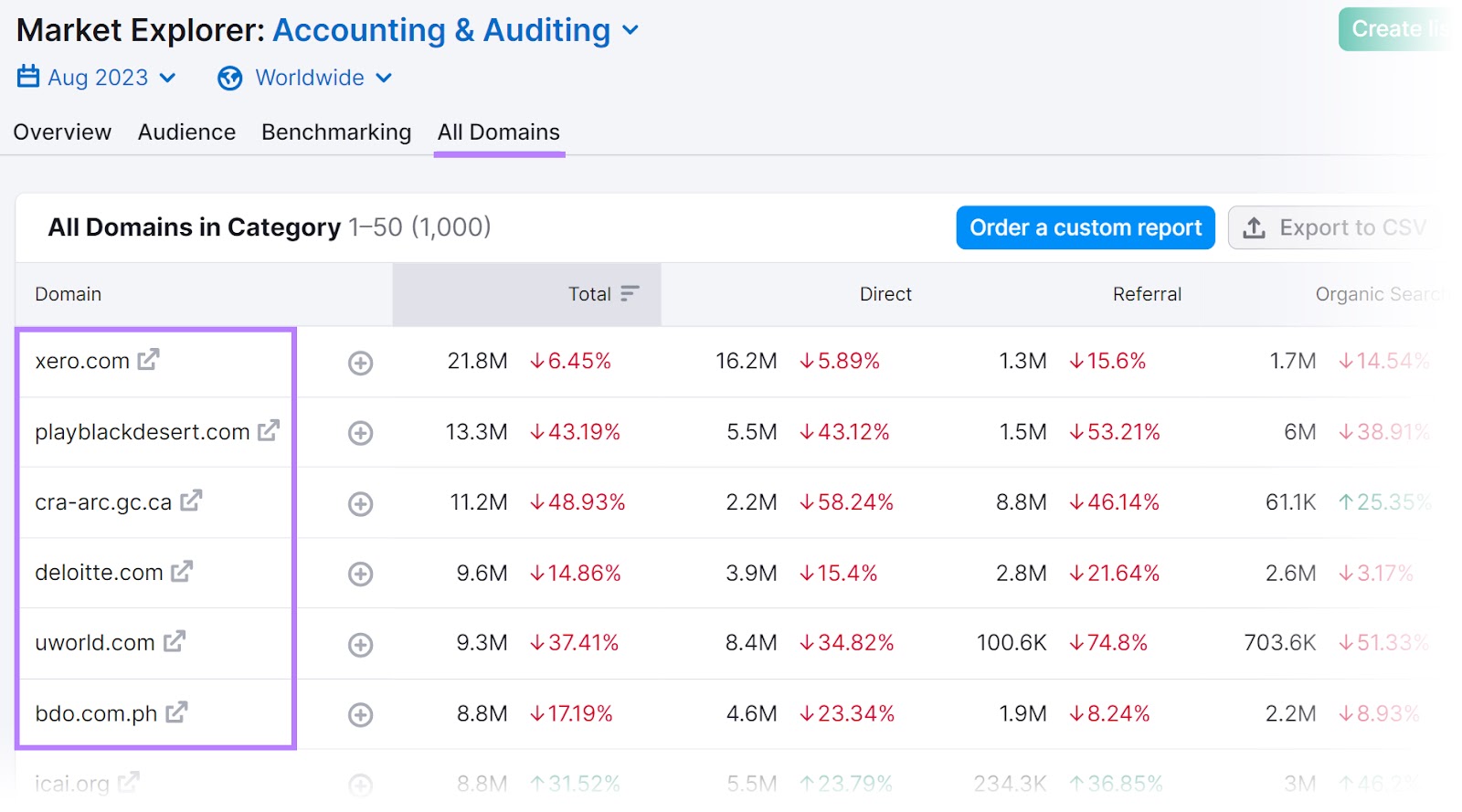
Don’t look into too many details yet. Just get a general idea of who you’re competing against for now.
We’ll conduct an in-depth analysis of these competitors a bit later.
3. Get to Know Your Target Audience
After you’ve gathered basic information about your market, it’s time to focus on people who really matter—your target audience.
Successful businesses solve a problem for someone. Your job is to figure out who that someone is. So you don’t end up wasting your resources.
So, where do you start?
Use audience research tools like One2Target.
This gives you all the information you need to better understand your target audience.
Open the tool, enter at least one competitor’s website, and click “Analyze.”
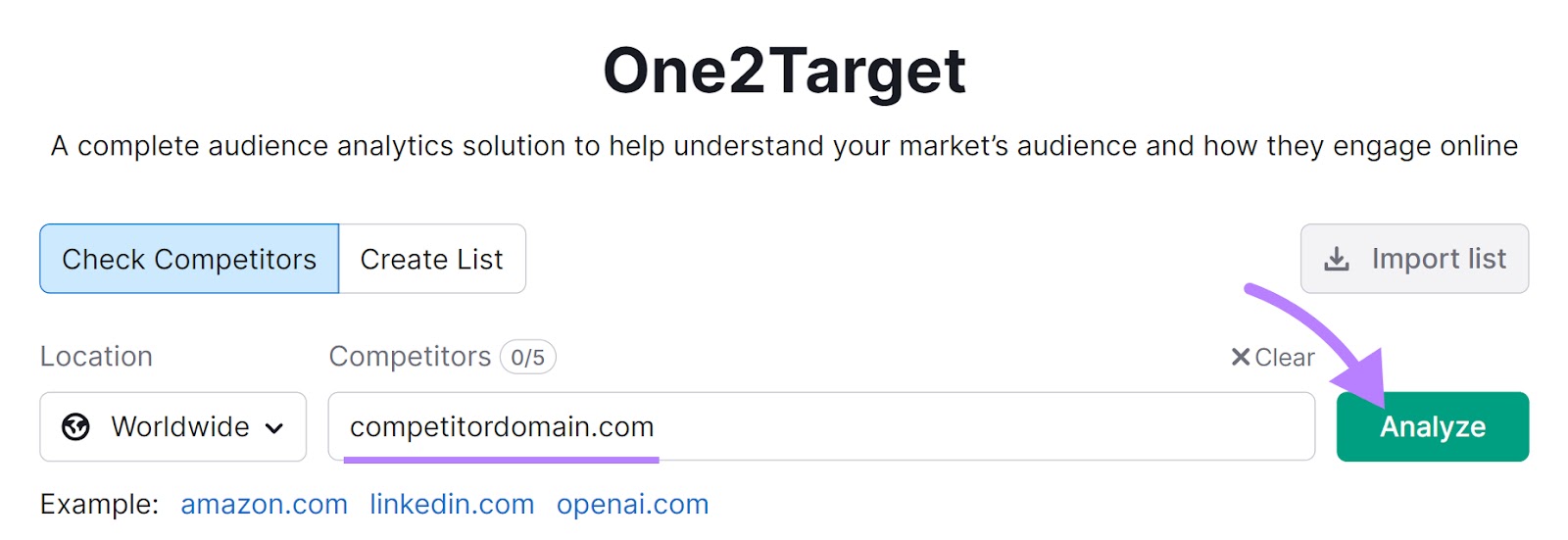
You’ll first see demographic information about this audience’s age, gender, and location:
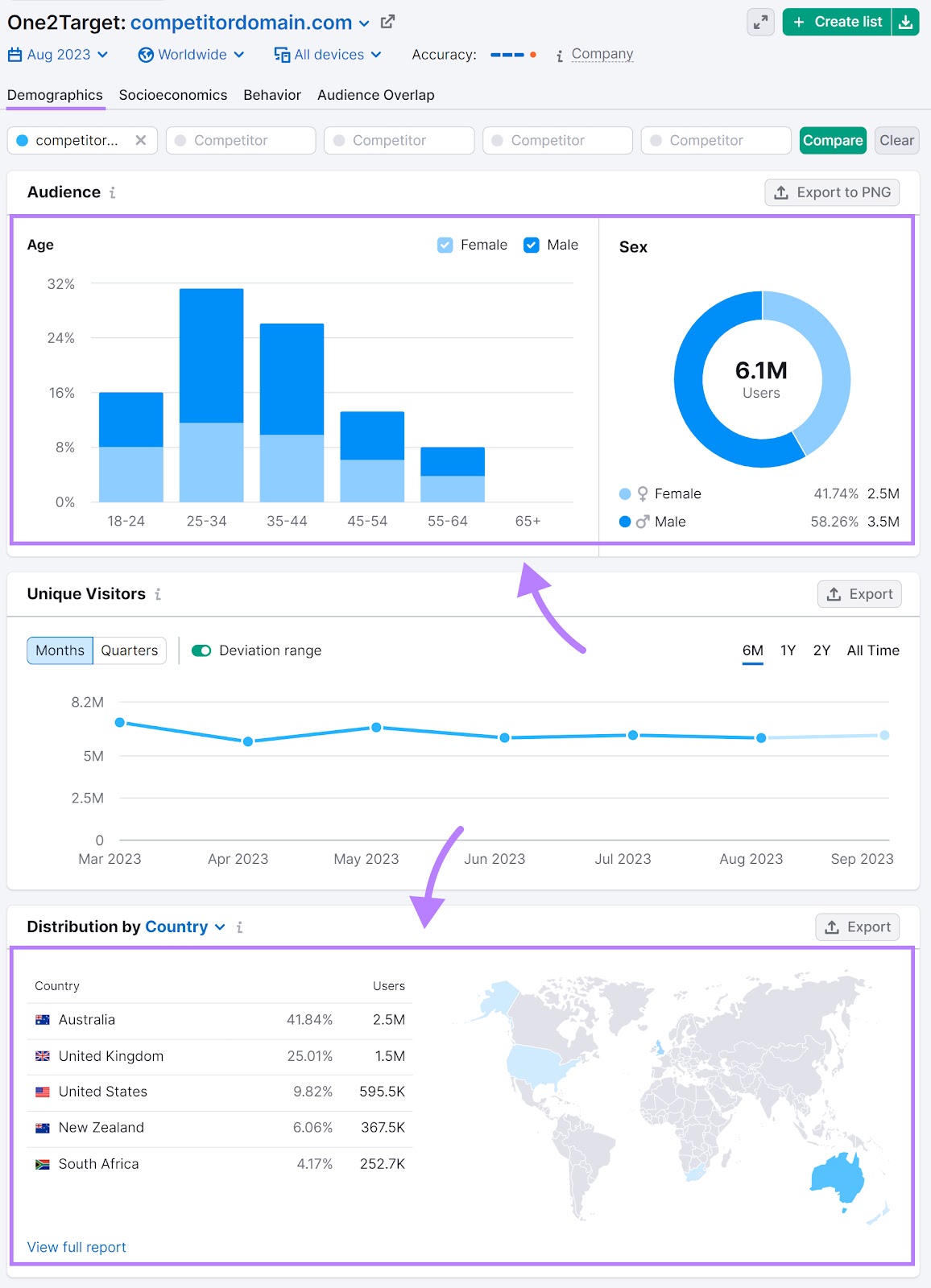
Go to the “Socioeconomics” tab to learn about their household size, income level, employment status, and education level:
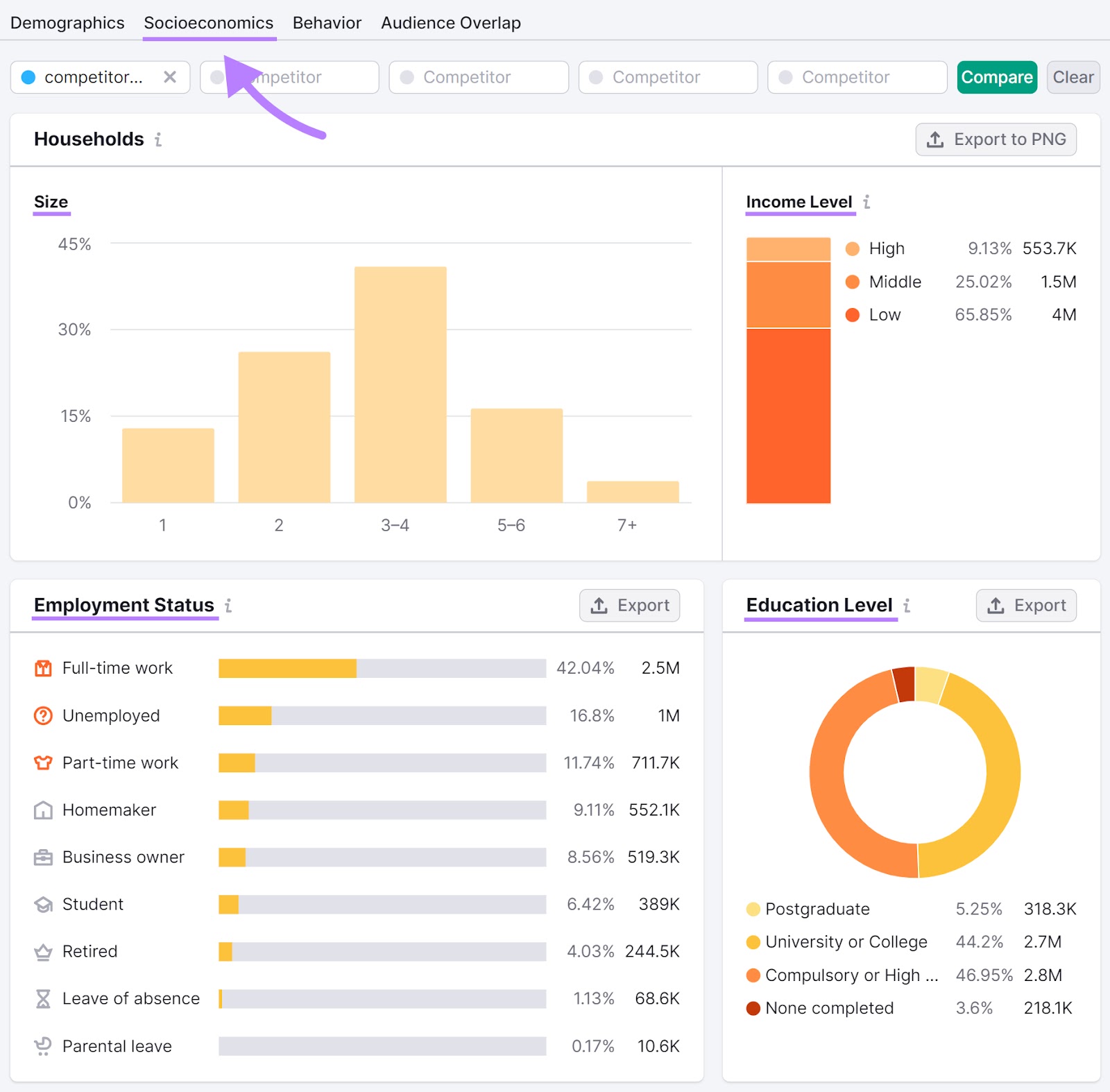
You can even see which social media platforms they use by going to the “Behavior” tab.
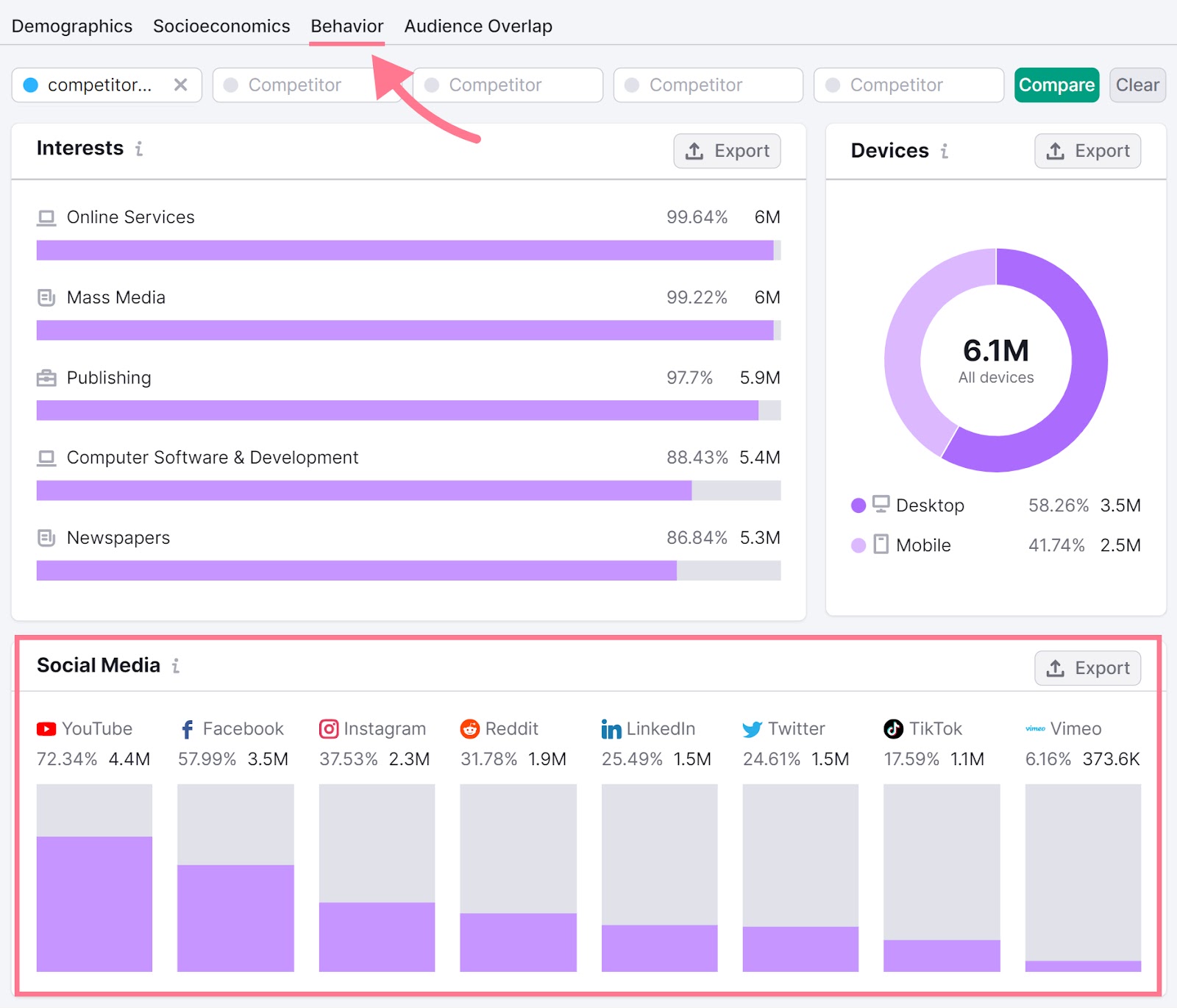
How can you make use of all this information?
Let’s break it down:
- Age and gender: This gives you an idea of the kind of language and references you should use in your marketing materials. For example, if your audience is predominantly millennials who are women, that lets you know what types of examples will be most relevant to them.
- Household size and income level: These can indicate your audience’s purchasing power and lifestyle. For example, an audience with a lower income may need more convincing about your product’s value for the price it commands.
- Employment status and education level: This can give you insights into how your audience might make purchasing decisions. For example, a highly educated audience might appreciate more detailed, technical information about your product or service.
- Social media platform use: This tells you which social media platforms to focus on. If your audience spends most of their time on Instagram, it doesn’t make sense to put all your effort into X (formerly Twitter).
Understanding these audience characteristics helps you tailor your marketing.
Remember: The more you know about your audience, the better you can market your product.
4. Analyze the Competition
A big part of doing a market analysis is studying your competitors.
Having a deep understanding of your competitors’ product offerings, pricing, and marketing tactics helps you spot gaps in your market and promote your products effectively.
Here’s how to analyze your competitors:
First, visit their websites.
Learn about which products or services they offer and how they position them. And look for gaps or areas where your product could provide unique value.
Second, look at their pricing. This will give you an idea of how you compare to similar products or services in the market.
And third, study which marketing channels competitors are using. If certain marketing channels are already working well for your competitors, they’ll probably work for you, too.
Use Semrush’s Traffic Analytics tool to see which marketing channels your competitors are using.
Open the tool, enter a competitor’s website, and click “Analyze.”
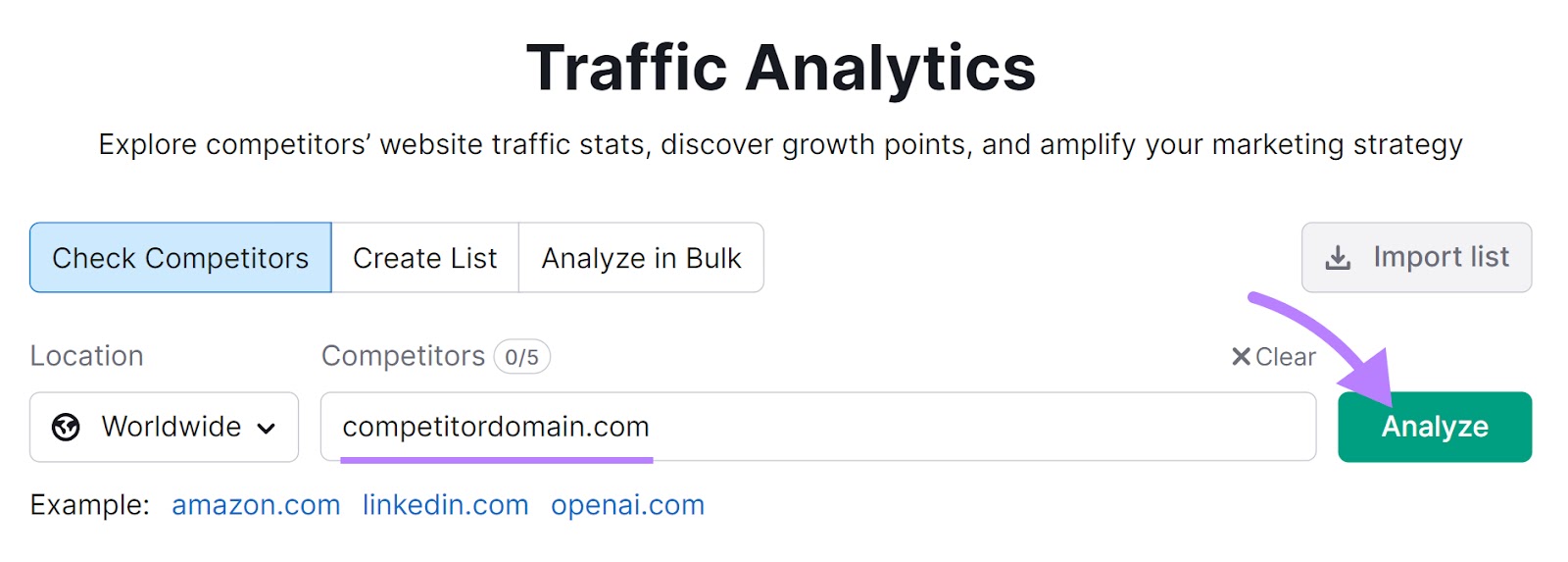
Then go to the “Traffic Journey” tab. You’ll see which marketing channels are driving the most traffic to your competitor’s website.
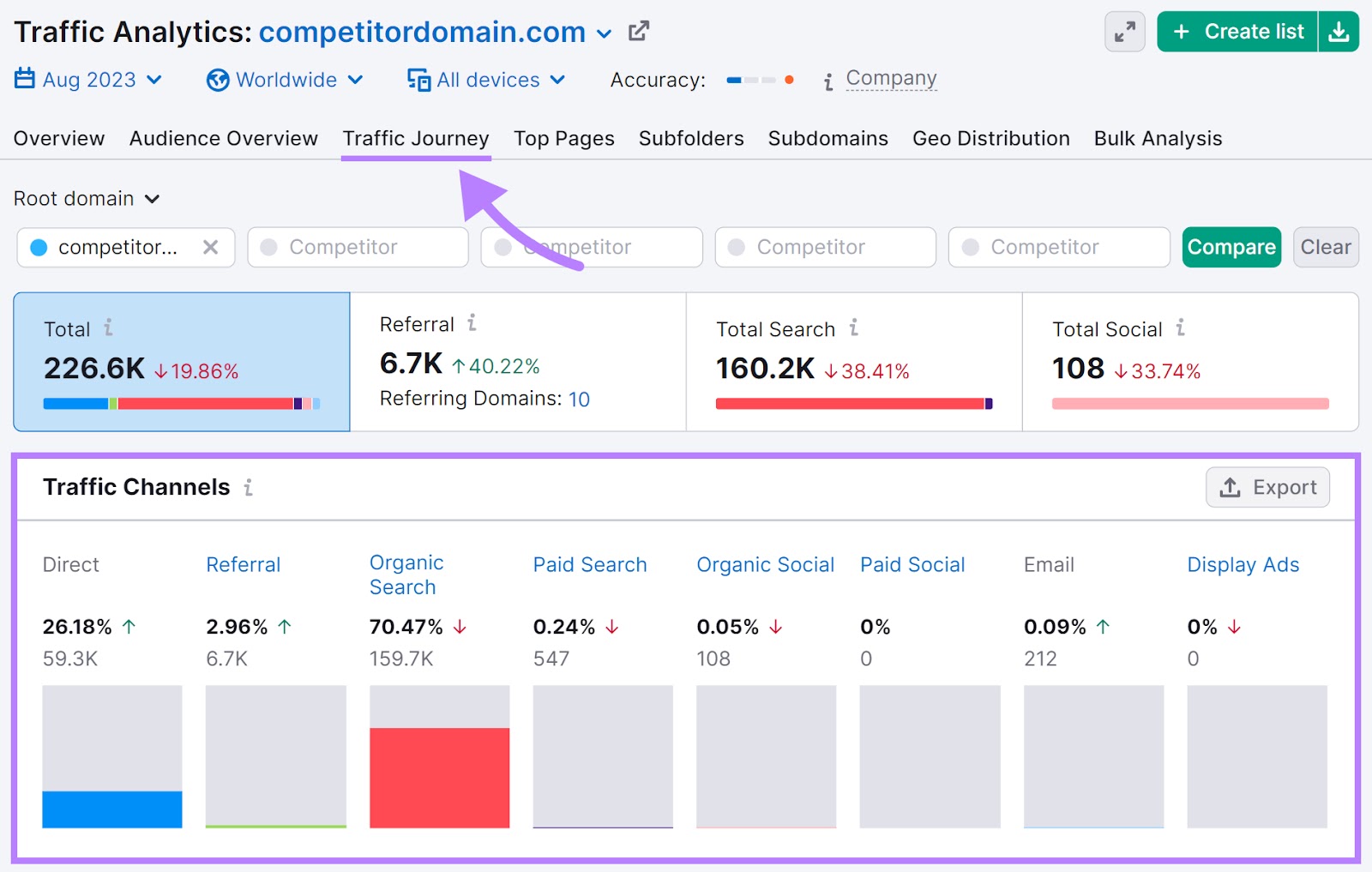
If you see most of the traffic is coming directly, that means they’re heavily focused on branding and traditional advertising.
But if you see a significant chunk of traffic coming from organic search, it indicates they have a strong SEO strategy in place.
And if email is a major source, it’s evident they’re leveraging email marketing effectively.
Use this data to prioritize your own marketing channels.
5. Perform a SWOT Analysis
After researching the overall market, the target audience, and the competitors, shift your attention inward by performing a SWOT analysis—a technique that helps you evaluate your own strengths, weaknesses, opportunities, and threats in relation to your market.
It can help you identify what makes you stand out from your competitors, what areas you need to improve on, what opportunities you can pursue, and what risks you need to avoid.
To perform a SWOT analysis, you need to ask yourself some questions about each of the four categories:
- Strengths: What are your advantages? What do you do well or better than others? What unique resources or capabilities do you have?
- Weaknesses: What are your disadvantages? What do you need to improve or avoid? What are the gaps or limitations in your resources or capabilities?
- Opportunities: What are the favorable trends or conditions in your market? What are your customers’ unmet needs or problems? Which new or emerging technologies can you leverage?
- Threats: What are the unfavorable trends or conditions in your market? What are the challenges or obstacles that you face? Which new or existing competitors threaten your position?
You can organize your answers in a table like this:
|
Strengths |
Weaknesses |
|
– First example strength |
– First example weakness |
|
– Second example strength |
– Second example weakness |
|
– Third example strength |
– Third example weakness |
|
Opportunities |
Threats |
|
– First example opportunity |
– First example threat |
|
– Second example opportunity |
– Second example threat |
|
– Third example opportunity |
– Third example threat |
A SWOT analysis can help you gain insights into your market and your competitive position.
You can use it to develop strategies that leverage your strengths, address your weaknesses, capitalize on your opportunities, and mitigate your threats.
6. Put Your Findings to Work
Take everything you learned from the research you’ve done so far and apply it to your business.
The goal of a market analysis isn’t just to collect data—it’s to use that data to make smarter decisions and grow your business.
Here are a few ways you can do that:
- Refine your unique selling proposition (USP): Use what you’ve learned about your competition to sharpen your USP. Did you uncover a feature that your competition doesn’t offer? Maybe that’s worth highlighting on your website and in your marketing materials.
- Improve your marketing channel mix: Use your insights about where your audience spends time online and which marketing channels your competition uses to better reach prospective customers. It’s all about reaching the right people at the right place with the right message.
- Mitigate risks: Leverage your SWOT analysis to anticipate challenges and build contingency plans. By acknowledging your business’s threats and weaknesses, you can create a strategy that includes ways to overcome these obstacles before they even become issues.
- Seize opportunities: Use your SWOT analysis to identify and take advantage of opportunities. These might be trends you’ve spotted, market gaps you’ve discovered, or new tools you’ve realized you can capitalize on.
And keep this in mind:
Doing a market analysis isn’t a one-time exercise.
Your market is always changing. So, you need to regularly monitor it to remain competitive.
Conduct Your First Market Analysis
Now that you know how to conduct a market analysis, take the next step and try it for yourself.
It’s not rocket science. With the right tools and framework, anyone can do it.
And Semrush has a suite of market analysis tools that can help you through almost every step involved in doing a market analysis.
Sign up today.
Source link : Semrush.com
